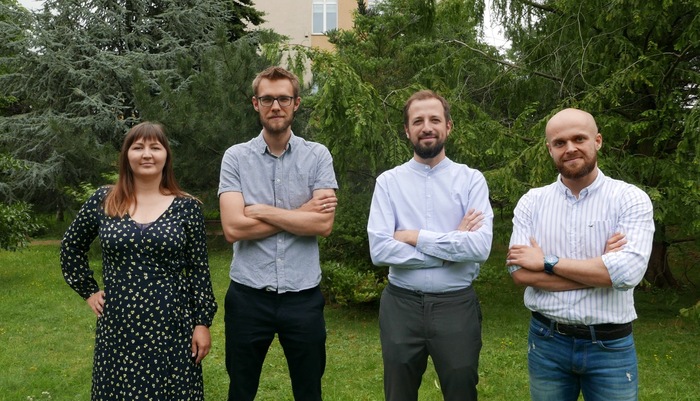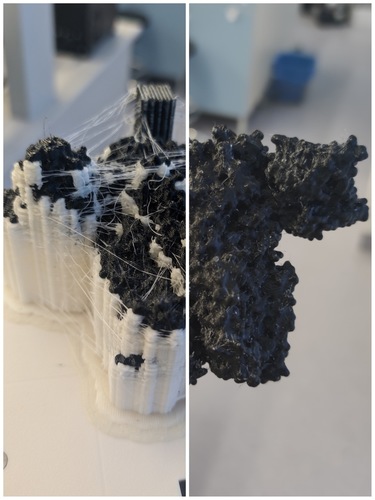Students and scientists printed models of the receptors
3.09.2021
Employees and doctoral students from the Department of Pharmaceutical Chemistry of the Medical University of Gdańsk, as well as members of the Student Scientific Circle operating at the Department, conducted under the supervision of Mariusz Belka, Pharm. D. Program for the visualization of drug action at the molecular level – educational and didactic project using 3D printing consisting in the creation of interaction models between the GABA receptor and drug molecules carried out as part of the Innovators project. The SSC tutor is Dr. Habil. Lucyna Konieczna, and the content supervision related to the introduction of new didactic solutions to the course of drug chemistry for pharmacy students was performed by Prof. Tomasz Bączek, Head of the Department.

Project participants (from the left): Dagmara Szynkiewicz, MPharm., Szymon Ulenberg, Pharm.D., Mariusz Belka, Pharm.D., Paul Georgiev, Eng.
The project aimed to develop teaching aids to help students understand how molecules of different drugs and toxins can bind to the same receptor with different effects on the human body. The molecular action of drugs is difficult to understand because it is invisible to the naked eye, and the GABA receptor is additionally sensitive to many substances with various chemical structures and effects. For better understanding, a model was first printed showing the actual appearance of the receptor as a folded protein with a complex structure. Then, a simplified mobile model of the receptor was developed and printed, and finally a model with marked binding sites of selected substances: diazepam, alprazolam, flumazenil, bicuculin and picrotoxin. The binding sites in the model were based on the three-dimensional structures of the receptor with substances obtained by electron microscopy and crystallography – available at the Protein Data Bank.

A realistic model of the GABA receptor based on the structure of the proteins that make it up. On the left side you can see support structures removed after the 3D printing process. On the right, a finished model.
In addition to detailed information on the structure and operation of the GABA receptor and the influence of drugs on its action, students also had the opportunity to explore the details of 3D printing, which has been increasingly used in the MUG for several years. They learned the basics of designing three-dimensional objects, developing them and preparing files for printing, working with a printer and solving problems. From the very beginning, the work progress was registered on Facebook on the Druk 3D GUMed, Chemia Farmaceutyczna profile. There you will find the most important information from individual stages of implementation, from the acquisition and use of PDB structures, through model development, virtual cutting in the Z-Suite program, to 3D printing on the Zortrax Inventure printer, received for the project from Zortrax cooperating with researchers. The final effect of the work is visible in the video.
3D printing is developing dynamically and is used in other branches of industry and science. In the field of medicine, it is used successfully, incl. for printing personalized prostheses or three-dimensional anatomical models facilitating the planning of medical procedures. In pharmacy, printed forms of the drug are intensively developed and various ways to improve pharmaceutical analytics. For several years, 3D printing has been used in the development of new analytical solutions at the Department of Pharmaceutical Chemistry of the MUG. by using new materials to extract drugs from biological tests.
Archives
- Academic Year 2024/2025
- Academic Year 2023/2024
- Academic Year 2022/2023
- Academic Year 2021/2022
- Academic Year 2020/2021
- Academic Year 2019/2020
- Academic Year 2018/2019
- Academic Year 2017/2018
- Academic Year 2016/2017
- Academic Year 2015/2016
- Academic Year 2014/2015
- Academic Year 2013/2014
- Academic Year 2012/2013

